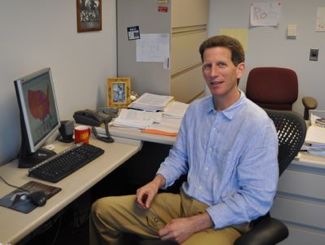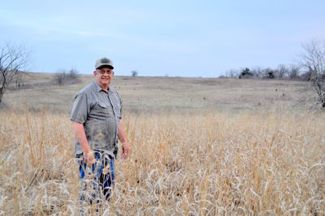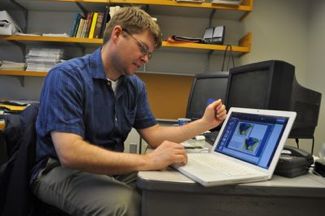The Future of Biofuels and the Weather
Air Date: Week of March 4, 2011

Farmer John Sellers grows switchgrass in southern Iowa. (Photo: Lisa Raffensperger)
The call for energy independence – and a federal mandate to increase use of renewable fuels - has farmers and scientists looking to new biofuel crops like switchgrass. But these new crops need water and they also may affect the water cycle. IEEE Spectrum’s Lisa Raffensperger reports on a team at Iowa State University that is studying computer models to see how biofuels may change the agricultural landscape and the weather.
Transcript
GELLERMAN: It’s Living on Earth, I’m Bruce Gellerman. As oil prices soar, the call for energy independence is growing loud. And the nation’s farmers are getting the message: They’re eager to grow biofuels to fill gas tanks and meet the goal. The debate over biofuels is typically about using farmland for food or fuel.
But there are questions about a more fundamental farm issue: water.
All those bioenergy crops could affect what's called the water cycle and possibly the weather. In Ames, Iowa, engineers are modeling the future of biofuels to get some answers. Lisa Raffensperger of the IEEE Spectrum, National Science Foundation program "The Water-Energy Crunch: A Powerful Puzzle," has our report.
[MOUSE CLICKS, COMPUTER SOUNDS]
RAFFENSPERGER: In a tiny windowless office on the Iowa State University campus, engineer Brian Gelder pulls up a map of the U.S. on his computer screen. It’s a vision of the future.
GELDER: In the high plains, especially in parts of Oklahoma and Kansas, we’re projecting fractions of the county that may reach up to about 45% of the county will be switchgrass in 2022.
RAFFENSPERGER: Nationwide, that adds up to an area about the size of Missouri newly planted in switchgrass. Behind the change is a law that requires 36 billion gallons of renewable fuel to be blended into our gasoline by the year 2022. Switchgrass is one of the most promising of the biofuel crops.
ANEX: So if we're going to make biofuels, it's not a little marginal change in the landscape. We're going to make a big change.

Rob Anex, an associate professor at Iowa State University, is part of a team looking at how biofuel crops may change the weather. (Photo: Lisa Raffensperger)
RAFFENSPERGER: That’s Rob Anex, also at Iowa State. His team is creating computer models to predict what this big change may mean for the weather. How do plants affect the weather? Well, when plants breathe out oxygen, it’s saturated with water. That’s called transpiration. Switchgrass will grow larger than corn on the same amount of land, but it’ll also suck more water from the soil and transpire more water. That water will go into the atmosphere, and come down as rain somewhere else.
[WIND AND BLOWING GRASS]
RAFFENSPERGER: It’s sunset in rural southern Iowa, and a spring storm is moving in. The switchgrass, dry beige stems about waist high, bends over nearly flat in the wind. This is what large swaths of Oklahoma and Kansas will soon look like if the models are correct.
[FOOTSTEPS ON THE GRASS]
RAFFENSPERGER: This field belongs to farmer John Sellers. He’s a sort of switchgrass guru.
SELLERS: That’s the beauty of these native grasses. They hide all of the nutrients in this plant in the root all winter long.

Farmer John Sellers grows switchgrass in southern Iowa. (Photo: Lisa Raffensperger)
RAFFENSPERGER: Switchgrass has many beauties, actually. It’s native, not a food crop, and can grow on marginal land. It’s also highly productive. Near where Sellers lives, an average acre of land produces 4.7 tons of corn, but could produce 5 and a half tons of switchgrass, which could someday mean a lot more ethanol produced.
But it’ll also mean a lot more water. Back at Iowa State University, Rob Anex explains the correlation.
ANEX: There's a nice linear relationship there, that if you want more biomass, you're going to transpire more water.
RAFFENSPERGER: For instance, that bonus growth of switchgrass in southern Iowa - each acre will transpire about 30,000 additional gallons of water into the atmosphere. To see how changing crops could affect the water cycle, the Iowa State team ran a test of their weather model. Chris Anderson is a climate scientist working on the project.
ANDERSON: We extracted one day in 1980 from it, and that day was February 26th in 1980.

Climate scientist Chris Anderson of Iowa State uses computer models to see how crops like switchgrass affect the water cycle. (Photo: Lisa Raffensperger)
RAFFENSPERGER: And on that day, they asked a simple question: what if almost all of Kansas, Oklahoma, and the Texas panhandle had been growing switchgrass? How would the summer of 1980 have turned out? Anderson points to a blotch of blue covering western Kansas and Oklahoma.
ANDERSON: And you can see it's drawing from this soil moisture level and reducing the amount of soil moisture down there. In this case, it reduced it by about 5 percent.
RAFFENSPERGER: And on a different map, rainfall. There’s a band of yellow and red from Iowa to Michigan.
ANDERSON: So the crop is putting more moisture in the air. It's going downwind and it's creating more storms.
RAFFENSPERGER: The team is currently running models of an alternate past - how weather would have looked over 25 years if switchgrass had covered as much land as it’s projected to in 2022. They expect to see more rainfall downwind of the switchgrass. They also expect more intense rains, the kind that cause erosion and flash flooding. So, should we be worried? When you ask Rob Anex, he pauses.
ANEX: It all depends on how we decide to make biofuels. And the reason that I'm hedging and saying it that way is that there's lots of different ways to grow biomass.
RAFFENSPERGER: Using agricultural waste like corn leaves and stalks won’t require more cropland or water. And some places have enough water for new crops. Anex hopes policymakers carefully consider the larger picture of biofuels and the water cycle, because it’s a complicated one.
ANEX: What we do on the landscape, how we use our land, affects the weather, but it affects the weather in other places.
RAFFENSPERGER: As homesteaders in the American West once said, ‘Rain follows the plow.’ Though now we’re learning it may follow from a longer distance than they ever realized. For Living on Earth, I’m Lisa Raffensperger.
GELLERMAN: Lisa’s story is part of the IEEE Spectrum, National Science Foundation program "The Water-Energy Crunch: A Powerful Puzzle."
Links
IEEE Spectrum's Engineers of the New Millennium: The Water-Energy Crunch: A Power Puzzle
Rob Anex, Assoc. Professor, Iowa State University
Chris Anderson, Scientist, Climate Science Program, Iowa State University
Living on Earth wants to hear from you!
Living on Earth
62 Calef Highway, Suite 212
Lee, NH 03861
Telephone: 617-287-4121
E-mail: comments@loe.org
Newsletter [Click here]
Donate to Living on Earth!
Living on Earth is an independent media program and relies entirely on contributions from listeners and institutions supporting public service. Please donate now to preserve an independent environmental voice.
NewsletterLiving on Earth offers a weekly delivery of the show's rundown to your mailbox. Sign up for our newsletter today!
 Sailors For The Sea: Be the change you want to sea.
Sailors For The Sea: Be the change you want to sea.
 The Grantham Foundation for the Protection of the Environment: Committed to protecting and improving the health of the global environment.
The Grantham Foundation for the Protection of the Environment: Committed to protecting and improving the health of the global environment.
 Contribute to Living on Earth and receive, as our gift to you, an archival print of one of Mark Seth Lender's extraordinary wildlife photographs. Follow the link to see Mark's current collection of photographs.
Contribute to Living on Earth and receive, as our gift to you, an archival print of one of Mark Seth Lender's extraordinary wildlife photographs. Follow the link to see Mark's current collection of photographs.
 Buy a signed copy of Mark Seth Lender's book Smeagull the Seagull & support Living on Earth
Buy a signed copy of Mark Seth Lender's book Smeagull the Seagull & support Living on Earth

